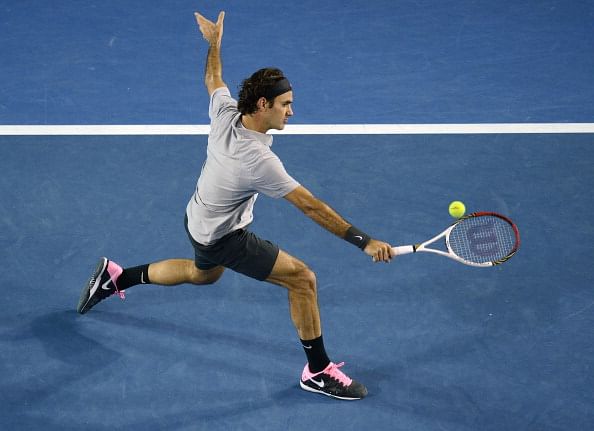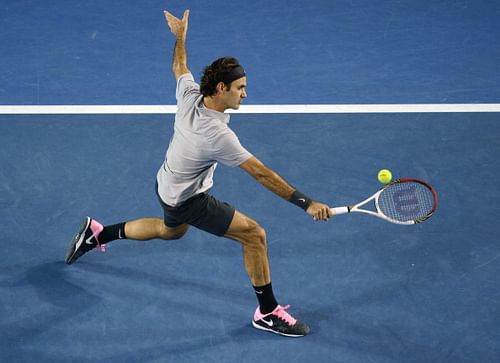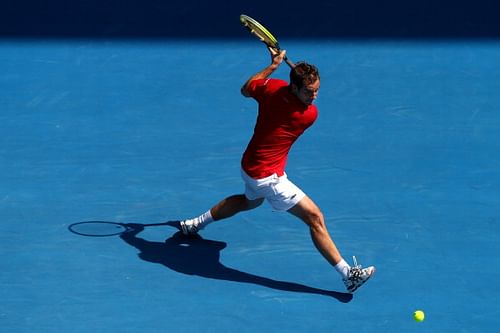
Tennis: Backhanded Compliments

“A backhand of beauty is a joy forever”.
Keats might not have exactly said this, but I am sure the thought would cross his mind if he was inclined towards tennis appreciation today. Being the sensitive soul he was, it would not have taken him long to zoom in on the single-handed backhand as the stroke that epitomizes everything that is graceful about the game. We might have even got an ode out of him on the subject. Imagine that.
Tennis is such a simple game, keep the ball in play within the lines and over the net until your opponent doesn’t, that it is quite surprising that there are so many ways to play it. From a game built around a powerful serve, to the nimble feet of a compulsive volleyer, to the remorseless grind of a baseliner, there is endless variety through subtle degrees of difference. But among them all, the player who does his most to elevate the sport to an art form is the exponent of the single-handed backhand (SHB). I wonder why this is so?
Variety: Could it be the range of strokes that can be conjured up by having an SHB at your disposal? From heavy top spin to deft slices, from powerful down-the-line drives to acute crosscourt placements, it can pretty much do everything, and more. All at the cost of some degree of control over the shot, but therein lies its greater charm, I think. There is a certain fearlessness and a sense of venturing into the unknown when an SHB exponent makes contact with the ball, quite often going by feel and intuition rather than vision and measurement. And our hearts go out to such dare-devils.
Trajectory: Maybe it’s the path the ball travels on, with an SHB groundstroke. Typically, SHB exponents take the ball much later and lower than the double-handed majority. This results in devious parabolic arcs that hint at the ball crashing into the net before it skims across to the other half of the court, leaving us with our hearts in our mouths. Or the deceptive shortening of length and change in pace provided by a well-disguised slice from the back of the court. More than anything, an SHB exposes us to the possibilities in the game, and brings out the three-dimensional nature of shot-making.
Poise: Could it be the fact that SHB exponents, after executing a shot, end up looking like ballerinas in full flow? Looking at a still of an SHB follow-through, with the racket and non-racket arms stretched in opposing directions, chest puffed out, and backfoot quite often in the air, it’s hard to imagine the incredible power that could be generated by the shot that just happened. No ungainly toppling forward and bent elbows of a double-hander, just the pleasure of pure balance and flowing strokes.
Rarity: Or maybe it’s just the fact that we see so less of it these days. The well-oiled power game of today quite often exposes the weaknesses of an SHB, making it, for most, an unviable tool. Efficiency and discipline have taken their toll on creativity and flair. The artist is no longer given a canvas to paint on. So much so, that the SHB is a forgotten art in the WTA (Justine Henin, where are your successors?). Over in the ATP, only 5 of the current top 20 players continue to valiantly ply their SHBs against the odds. So, when we do see a backhand sent curling by Gasquet or a down-the-line pounded by Dimitrov, our pulses quicken as we snatch at fond recollections of an alternate, and more pleasing, way that the game could be played.
Let me admit that the recently concluded Australian Open is the immediate trigger for this diatribe of mine. Hypnotized by the blue courts in Melbourne on TV over the last fortnight, I was further entranced during the mid-part of the tournament by a succession of SHB exponents who chose to take the spotlight and enthrall us with the possibilities of the single-hander.
First up, Stanislas ‘The Other Swiss’ Wawrinka played way above his level to take Djokovic down to the wire, in what easily turned out to be the best match of the tournament. The key weapon in his arsenal that night was his SHB, which has variously been described since as ‘clean’, ‘efficient’, ‘brilliant’, ‘brutal’, ‘killer’. They all hold true, and we always knew that about Wawrinka. What we didn’t know was that he could sustain his shotmaking for such a long time in such a high-stakes match. In the process, he became an ambassador for the shot.

The next day, I watched two Spaniards go at each other under the hot Australian summer sky. The much favoured David Ferrer, he of the terrier nature, was being shot off the court by some blistering SHBs, more scorching than the sun, gunned down by his compatriot and good friend, Nicolas Almagro. But in the end, friendship won over intent, the match fizzled out, and Almagro continued his woeful record against Ferrer. But for the first two sets, he had shown us what could be done when an SHB exponent catches fire in a match. Pretty much nothing, if you are the opponent.
By now, I was on a roll, having watched two five-setters almost back-to-back where the SHB had taken centre-stage, and I could not resist following the fortunes of the most evil genius of them all – Richard Gasquet. The Frenchman has the most distinctive backhand in the business, with a high wind-up and elaborate follow-through. It almost feels like he punctuates signatures in the air before and after executing the shot. But as much as his physical game is a sight to behold, his mental setup can be downright frustrating. It played to par in his quarterfinal as well. Flourishes of brilliance, but a tame and predictable defeat to countryman Jo-Wilfred Tsonga.

All through this, the best SHB player in the game was quietly moving through his quarter. It is hard to argue against Roger Federer being the single-most important force in keeping the SHB still relevant in the game today. If a 31-year old with a SHB can remain at the top of the sport and dominate power-hitters a decade younger than him, he can’t be doing much wrong, can he? Well, he didn’t put a foot wrong with either his backhand or forehand through the tournament, till he was swamped by the new Andy Murray wave in the semi-final.
But in the final analysis, each of these four exponents of the SHB, all gifted in their own way, ended up only playing to par in this Australian Open. They did not disappoint in their results, but they did not surprise either. What they did accomplish was emphasising the SHB in the consciousness of the tennis public. The jaw-dropping magnificence of a Wawrinka backhand, screaming across court and leaving the number one player in the world completely flummoxed, will remain etched in my mind for a long while. But to put things in perspective, the men’s final ended up being contested between two players dressed eerily alike and playing a game that has begun to resemble each others’ more and more, and taken on the definition of the tennis game of the future – hard, physical, punishing rallies from the baseline, with the double-hander backhand employed as an efficient, aggressive tool used to finish off points as ruthlessly as possible. As I watched Andy Murray execute another double-handed down-the-line winner from way behind the baseline, falling sideways and with both feet in the air, I shook my head in the middle of the raucous cheers that followed in appreciation of the splendid athletic effort.
With due apologies to Dostoevsky, and also to Janko Tipsarevic, I realized that beauty might not be enough to save the world.